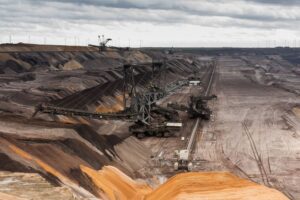Gold Breaks $4,200: Why ASX Gold Stocks Are Still Underperforming
![]() Ujjwal Maheshwari, October 17, 2025
Ujjwal Maheshwari, October 17, 2025
On 15 October 2025, gold breached US$4,200/oz for the first time, reaching a record high in an extraordinary rally. Yet despite that headline, Australia’s gold miners haven’t kept pace. The ASX Gold Index (XGD) has risen strongly over the past year, but the gap between physical gold and mining equities remains narrower than in past bull markets. That phenomenon begs a deeper look: why is there such a persistent gap between the metal’s performance and the stocks of ASX-listed gold producers? The answer lies in rising input costs, squeezed margins, regulatory burdens, investor sentiment, and capital discipline. Over the coming sections, we dig into macro dynamics, individual company cases, valuation drivers, and what might finally close that gap for investors willing to look deeper.
What are the Best ASX stocks to invest in right now?
Check our buy/sell tips
Gold’s Record Run: Fear, Policy and Demand
Gold’s move above US$4,200 wasn’t a random spike. It was the culmination of macro forces that had been building for months. Renewed US–China trade tensions, stoked by the Trump administration’s threat of broader tariffs on technology and automotive imports, have rattled risk assets worldwide. That uncertainty has revived gold’s traditional role as a safe haven. Simultaneously, expectations of rate cuts by the U.S. Federal Reserve have driven real yields below 1 per cent, making non-yielding assets such as gold more attractive. Central banks, particularly in China, India, and Turkey, have remained active buyers of bullion, seeking diversification away from the U.S. dollar.
According to preliminary data from the World Gold Council, central-bank demand remained strong through the September quarter, while ETF flows have recently stabilised after nearly two years of outflows. At the same time, geopolitical flashpoints from the Middle East to the South China Sea have elevated risk premiums. Investors, weary of equities priced for perfection, have shifted allocations to tangible stores of value. All this has driven gold’s ascent to a new plateau. Yet, while the metal’s fundamentals appear stronger than ever, the same can’t be said for the miners digging it up.
When Costs Eat the Rally
It might sound counterintuitive, but many producers are earning less profit per ounce than they did when gold was cheaper. Inflation is the culprit. Across the industry, all-in sustaining costs (AISC) have increased notably, with many Australian producers reporting costs in the A$1,700–A$1,900 per ounce range in recent quarters. Labour shortages in Western Australia, soaring energy prices, and rising contractor rates have combined to erode margins. The result is that even with gold selling above A$6,400 an ounce in local terms, cash flow isn’t rising proportionately.
Consider Northern Star Resources (ASX: NST). Two years ago, it maintained stronger profit margins per ounce, but recent inflationary pressures have narrowed that gap. Evolution Mining (ASX: EVN) faces a similar squeeze, managing higher energy and contractor costs amid underground expansions and grade variation at Cowal and Ernest Henry. Investors understand that higher costs are now a structural rather than cyclical feature of the industry, and that awareness is keeping valuations in check. The market is not discounting the gold price; it’s discounting the risk that miners fail to translate those prices into profits.
Northern Star (ASX: NST): Scale with Caution
Northern Star (ASX: NST) remains the heavyweight of Australia’s gold sector, producing over 1.6 million ounces annually from its operations in Kalgoorlie, Yandal, and Alaska’s Pogo mine. Its share price has posted solid gains this year, though valuations remain below long-term averages. The company’s fundamentals remain strong: a robust balance sheet, low leverage, and a clear growth pipeline. Analysts currently value the stock near mid-teens earnings multiples, reflecting investor caution over cost escalation, lingering integration issues from past mergers, and exposure to U.S. operational risk in a volatile political environment.
That said, Northern Star offers scale, longevity, and operational leverage if costs stabilise. It remains one of the few ASX gold producers capable of generating consistent free cash flow through the cycle. It’s the benchmark stock, but the market wants proof of sustained efficiency before assigning it a richer multiple.
Evolution Mining (ASX: EVN): A Story of Recovery
Evolution Mining (ASX: EVN) sits in a different camp, the comeback story. After several challenging years, Evolution has shown improvement, with a steady share-price recovery in 2025. Production gains from Cowal Underground and strong contributions from Ernest Henry have helped, while debt reduction has strengthened the balance sheet. But costs remain stubbornly high, and the company has been open about the operational challenges of maintaining grades and managing contractors.
Evolution now trades at relatively lower EV/EBITDA multiples compared to global peers such as Barrick and Newmont. The market is clearly waiting to see sustained delivery before re-rating the stock. If management can demonstrate consistent output and further cost improvement, Evolution could become one of the best-performing mid-tier miners on the ASX over the next year.
Newmont Corporation (ASX: NEM): Scale, But No Spark
When Newmont Corporation (ASX: NEM) acquired Newcrest Mining in 2023, it created the world’s largest gold company and secured control over major Australian assets, including Cadia, Telfer, and Lihir. On paper, the deal should have turbocharged returns. Instead, integration challenges and capital allocation issues have kept investors cautious. Newmont’s ASX-listed shares have lagged peers since the acquisition, with concerns around synergy realisation and cost control weighing on sentiment.
Nevertheless, Newmont remains a defensive play. Its dividend yield of around 3.5 per cent appeals to income investors, and its global diversification offers some insulation from local shocks. If management can streamline its Australian operations and extract the promised efficiencies from Newcrest, the world’s biggest gold miner could finally start to shine on the ASX.
The Valuation Gap That Won’t Close
Historically, gold miners outperform the metal by a wide margin during bull markets. The logic is simple: their revenues rise with gold, but costs rise more slowly, boosting profits. Yet in 2025, that leverage has collapsed. Despite gold’s strong performance in AUD terms, the ASX Gold Index has advanced by a smaller margin. In normal times, the multiple of outperformance would be at least two to one.
The reasons are structural. Margin pressure, ESG costs, capital intensity, and investor preference for simpler exposures, such as physical ETFs, have changed the equation. Investors no longer assume miners automatically outperform the metal; instead, they demand proof of execution. Analysts note that Australian gold producers continue to trade at valuation discounts to global peers on EV/EBITDA multiples, reflecting persistent cost pressures and cautious investor sentiment. For contrarian investors, that discount could represent an opportunity, but it also reflects legitimate caution.
The ESG and Regulation Squeeze
While environmental, social, and governance standards are now an integral part of mining investment, they come at a price. Western Australia’s tightening of tailings-management and emission standards has significantly lifted sustaining capital requirements. Northern Star has committed around A$150 million to decarbonisation and renewable-power projects, while Evolution is investing in solar and hybrid energy systems at several mines. These initiatives are essential to maintaining institutional support, yet they also suppress near-term returns.
For ESG-focused funds, the preference for low-carbon portfolios means higher-emission miners may face both higher capital costs and valuation penalties. That shift is reshaping the sector’s economics. It’s no longer just about how much gold a company can mine, but how cleanly and sustainably it can do so. In the long run, that could make the sector more resilient; in the short run, it’s another reason shares lag the metal.
The Currency Cushion — and Its Limits
One factor keeping Australia’s gold industry profitable has been the weak Australian dollar. At an exchange rate around 0.64 USD/AUD, gold at US$4,200 equates to roughly A$6,560 per ounce, among the highest local gold prices recorded. That provides a vital cushion against global cost inflation. Many local producers effectively operate in a weaker-currency environment, earning U.S.-dollar revenues but paying Australian-dollar costs.
However, the currency tailwind cuts both ways. If the Reserve Bank of Australia signals tighter policy in 2026, or if global growth rebounds, the Australian dollar could strengthen. Even a modest appreciation could trim margins materially. Investors in gold equities need to watch not only the metal’s global price but also its performance in Australian dollars, the key metric for local profitability.
Sentiment Fatigue and the Rotation Problem
Perhaps the biggest invisible weight on ASX gold stocks is sentiment. After years of underwhelming performance relative to lithium, uranium, and AI-linked tech names, gold equities have simply fallen out of fashion. Fund managers tend to chase momentum, and for much of the past three years, momentum has lived elsewhere. The perception that gold miners are high-cost, low-growth, and capital-intensive has made them an afterthought for many institutional portfolios.
This fatigue is self-reinforcing. As fewer investors participate, liquidity declines, valuations remain depressed, and the cycle continues. Yet history suggests that such neglect can be the best time to buy. When gold trades above its inflation-adjusted mean for several quarters, miners often stage powerful catch-up rallies. If inflation remains sticky and interest rates begin to ease, that scenario could easily repeat in 2026.
M&A Momentum on the Horizon
Periods of underperformance often sow the seeds of consolidation, and the Australian gold sector may be entering another such phase. Cash-rich producers could soon look to acquire undervalued peers to boost production and cut costs. Companies like Genesis Minerals (ASX: GMD) and De Grey Mining (ASX: DEG) are widely viewed as potential takeover targets, especially with De Grey’s Hemi project nearing production. The strategic logic is clear: combine balance-sheet strength with growth optionality while spreading overheads. Mergers funded through equity rather than debt could accelerate this trend, allowing larger players to expand without overleveraging. For investors, successful M&A often triggers re-ratings across the sector. The market rewards discipline, but it also rewards action when valuations are depressed.
What Could Turn the Tide?
For gold miners to outperform decisively, several ingredients need to align. Sustained gold prices above A$6,000 per ounce for consecutive quarters would rebuild confidence in margins and cash generation. A moderation in input inflation, particularly in energy and labour, would further improve free cash flow. Continued weakness in the Australian dollar would preserve the currency tailwind, while a breakout in M&A could signal confidence returning to the sector. Above all, consistent operational delivery from leaders such as Northern Star and Evolution could reset sentiment around the quality of ASX-listed gold producers.
If even two of these catalysts emerge simultaneously, the valuation gap between gold and gold equities could narrow quickly. Investors are watching closely, waiting for a spark that converts solid gold prices into equally solid equity returns.
Conclusion
Gold breaking US$4,200 is not just a headline; it’s a reflection of deep unease in global markets. Yet the underperformance of ASX gold stocks tells a more nuanced story about cost inflation, regulation, and investor psychology. The sector is not broken; it’s evolving. For disciplined investors, this divergence between metal and miners is less a red flag than an opening. The market has discounted the risks heavily, but it may be underestimating the resilience of Australia’s best operators.
It suggests that the next phase for ASX gold miners will depend less on the metal’s price and more on how efficiently companies manage costs, navigate ESG transitions, and pursue strategic consolidation. When those factors align, and history suggests they eventually do, today’s laggards could become tomorrow’s quiet outperformers. For long-term investors willing to look past sentiment, the gold trade may still have plenty of life left.
FAQs
- Why are ASX gold stocks lagging despite record gold prices?
Rising production and energy costs have squeezed margins, while ESG and regulatory expenses have weighed on profitability, offsetting the benefits of higher gold prices.
- Which ASX gold companies currently look most attractive?
Northern Star and Evolution stand out for their scale and operational improvements, while De Grey Mining offers leverage for growth through its Hemi development.
- How does the Australian dollar influence miners’ profits?
A weaker dollar boosts local gold prices and cushions margins, but any rebound in the currency could erode that advantage even if global gold prices hold steady.
- Is the current underperformance temporary?
Historically, when gold prices remain high for multiple quarters, equities tend to follow up. Sustained margins and M&A activity could drive a re-rating in 2026.
- Should investors consider physical gold instead of miners?
Physical gold offers stability and simplicity, but miners can provide leverage when costs stabilise and sentiment recovers. Diversification between the two may be the prudent strategy.
Blog Categories
Get Our Top 5 ASX Stocks for FY26
Recent Posts
Webjet Sinks 22 Percent After Softer H1 Results and Weak Domestic Demand
Webjet Falls 22 Percent After H1 Revenue Dips and Domestic Flight Demand Softens Webjet (ASX: WJL) opened down 22 percent…
Javelin Minerals Jumps 2,900 Percent on Capital Consolidation
A Sharper Share Register Sets Javelin Minerals Up for Its Next Corporate Stage Javelin Minerals (ASX: JAV) surged an extraordinary…
Why Are Droneshield Shares Dropping and Should You Be Worried
DroneShield Selloff Tests Nerves, But Fundamentals Tell a Different Story DroneShield (ASX: DRO) experienced a sharp selloff this morning that…



